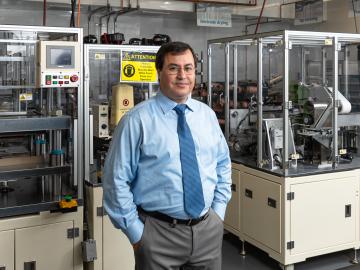
Filter News
Area of Research
- Advanced Manufacturing (3)
- Biology and Environment (7)
- Computational Biology (1)
- Computer Science (3)
- Electricity and Smart Grid (1)
- Energy Science (68)
- Energy Sciences (1)
- Fusion and Fission (7)
- Fusion Energy (3)
- Isotopes (14)
- Materials (28)
- Materials for Computing (11)
- National Security (5)
- Neutron Science (50)
- Nuclear Science and Technology (13)
- Nuclear Systems Modeling, Simulation and Validation (1)
- Sensors and Controls (1)
- Supercomputing (23)
- Transportation Systems (1)
News Topics
- (-) Advanced Reactors (16)
- (-) Artificial Intelligence (16)
- (-) Energy Storage (43)
- (-) Exascale Computing (6)
- (-) Grid (17)
- (-) Isotopes (20)
- (-) Neutron Science (58)
- (-) Space Exploration (6)
- (-) Transportation (38)
- 3-D Printing/Advanced Manufacturing (55)
- Big Data (18)
- Bioenergy (28)
- Biology (30)
- Biomedical (32)
- Biotechnology (7)
- Buildings (14)
- Chemical Sciences (12)
- Clean Water (10)
- Composites (8)
- Computer Science (75)
- Coronavirus (35)
- Critical Materials (6)
- Cybersecurity (11)
- Environment (72)
- Frontier (5)
- Fusion (22)
- High-Performance Computing (22)
- ITER (4)
- Machine Learning (9)
- Materials (34)
- Materials Science (61)
- Mathematics (3)
- Mercury (5)
- Microscopy (19)
- Molten Salt (2)
- Nanotechnology (27)
- National Security (9)
- Nuclear Energy (37)
- Physics (18)
- Polymers (12)
- Quantum Computing (5)
- Quantum Science (26)
- Security (6)
- Statistics (1)
- Summit (26)
Media Contacts

Ilias Belharouak is leading ORNL’s research efforts in investigating new materials for solid-state batteries, which can double the charging capacity of lithium-ion batteries, commonly used today for electronic devices such as cell phones.

A software package, 10 years in the making, that can predict the behavior of nuclear reactors’ cores with stunning accuracy has been licensed commercially for the first time.

A versatile class of flexible, protein-like polymers could significantly advance future drug delivery methods. But first, scientists have to develop a reliable process for tailoring these polymers into shapes that can effectively transport medicines throughout the human body.

Biological membranes, such as the “walls” of most types of living cells, primarily consist of a double layer of lipids, or “lipid bilayer,” that forms the structure, and a variety of embedded and attached proteins with highly specialized functions, including proteins that rapidly and selectively transport ions and molecules in and out of the cell.

Each year, approximately 6 billion gallons of fuel are wasted as vehicles wait at stop lights or sit in dense traffic with engines idling, according to US Department of Energy estimates.

As the second-leading cause of death in the United States, cancer is a public health crisis that afflicts nearly one in two people during their lifetime.
A team of scientists led by Oak Ridge National Laboratory found that while all regions of the country can expect an earlier start to the growing season as temperatures rise, the trend is likely to become more variable year-over-year in hotter regions.

Researchers at ORNL demonstrated that sodium-ion batteries can serve as a low-cost, high performance substitute for rechargeable lithium-ion batteries commonly used in robotics, power tools, and grid-scale energy storage.

Energy storage startup SPARKZ Inc. has exclusively licensed five battery technologies from the Department of Energy’s Oak Ridge National Laboratory designed to eliminate cobalt metal in lithium-ion batteries. The advancement is aimed at accelerating the production of electric vehicles and energy storage solutions for the power grid.

The formation of lithium dendrites is still a mystery, but materials engineers study the conditions that enable dendrites and how to stop them.


